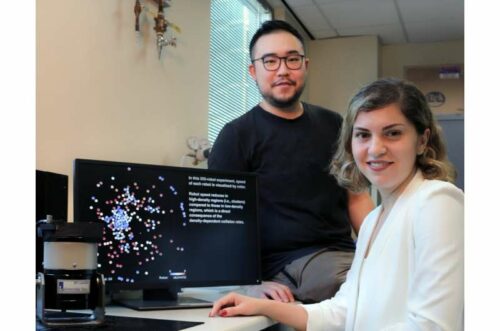Researchers develop a way to influence microbots to form clusters using collision induced aggregations to create spatial coverage.

Microbots are designed to perform precision tasks. These tiny robots may seem to be like nothing but when it links with the rest of its pals, things get a little more interesting. Application of this tech is limitless for example, construction : what takes teams of people working by hand for months and years can be accomplished just by a few people using microbots. They can be ideal for drug delivery, disease diagnosis and even surgeries.
The small scale may limit them to sensing and communication but researchers at Georgia Institute of Technology have developed a way to enhance their ability to collaborate efficiently. The work offers a new system to control swarms of 300 3-millimeter micro bristle robots’ (microbots) ability to aggregate and disperse controllably without onboard sensing.
“By collaborating with roboticists we were able to ‘close the gap’ between single robot design and swarm control,” said Azadeh Ansari, an assistant professor in the School of Electrical and Computer Engineering (ECE). “So I guess the different elements were there, and we just made the connection.”
Larger robots can perform actions based on the sensors incorporated inside their system. But these microbots do not have the capacity to carry the same sensors, communications, or power units. “Microbots are too small to interpret and make decisions, but by using the collision between them and how they respond to frequency and the amplitude of global vibration actuation, we could influence how individual robots move and the collective behaviors of hundreds and thousands of these tiny robots,” said Zhijian Hao, an ECE Ph.D. student.
Researchers used vibrations to control the motility characteristics and perform motility-induced phase separation (MIPS). The researchers borrowed the concept from thermodynamics, when an agitated material can change phases from solid to gas to liquid. They manipulated the level of vibration to influence the microbots to form clusters or disperse to create good spatial coverage.
Researchers developed computational models and a live tracking system for the 300-robot swarm using computer vision to better understand these phase separations. This enabled the researchers to analyze microrobots’ behavior and motion data that give rise to the swarm’s characteristics.
Reference : More information: Zhijian Hao et al, Controlling Collision-Induced Aggregations in a Swarm of Micro Bristle Robots, IEEE Transactions on Robotics (2022). DOI: 10.1109/TRO.2022.3189846







All website visitors will find it to be fantastic, and they will
I’m sure to benefit from it. I appreciate the insightful information you offer in your writings.
I’ll bookmark your site and come back frequently. apple repair dubai
I have no doubt that I will discover a tonne of new information right here!
Good luck with the upcoming!